Rheinbrot is a delicious bread that incorporates an overnight sponge of Reisling, sourdough, bread flour and water.
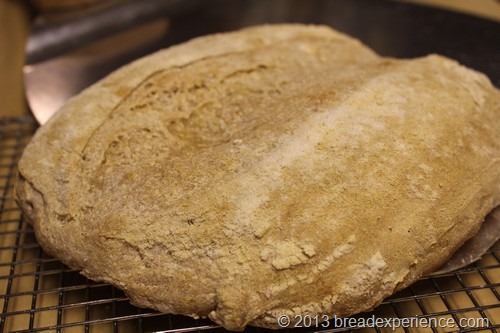
The life of a project manager can be hectic at times, particularly when several of your projects come due at the same time. This is what happened last week. During the day, I was on back-to-back conference calls and at night, I was brain dead. When Friday rolled around, all I wanted to do was to get my hands on some dough.
I was especially looking forward to making Rheinbrot, the featured bread for the BBBs (Bread Baking Babes). This bread, chosen by Astrid of PaulChen’s FoodBlog, is unique in that it utilizes an overnight sponge of Reisling, sourdough, bread flour and water.
According to Astrid,
“Rheinbrot got it’s name from the fact that there is (Rhein) Riesling used in the bread dough. A wine widely associated by the Winzers located at the Rhein in Germany. I’d like to add, that Austria has a fabulous Riesling too and that said by me who is not a huge fan of white wine anyway.”
I like breads that utilize an overnight ferment because they have more depth of flavor than breads made with a straight dough. Plus, it’s nice that you can mix up the sponge the night before and then finish the bread the next day after you’ve rested. Well, that was the plan anyway.
It was cloudy on Saturday, and my brain was cloudy as well. This lovely bread ended up being a winey pain in the brot. The dough was sticky and gave me fits during the final proof. I had to reshape the loaf three times because it kept sticking to the proofing basket when I tried to remove it to bake it.
I thought I had dusted the banneton with a mixture of all-purpose and white rice flour, but it didn’t work like it should’ve so my container must have only had all-purpose flour in it instead of the mixture. After the second attempt, my brain woke up a little, and I mixed some rice flour in with the other flour.
The loaf only stuck a little bit the third time, so I decided to go with it. It was over proofed and deflated a bit from when I removed it from the proofing basket, but even so, it turned out pretty tasty.
The third time is the charm, right! Well here is the charm with a slight blemish from being stuck to the basket.
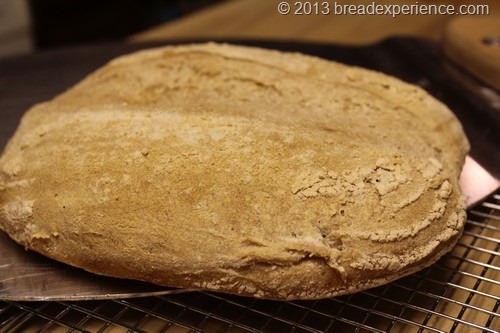
Rheinbrot
The formula for this winey loaf was translated from this forum where the chemics of wine and bread baking are discussed.
Here is my adapted version:
Sponge:
- 50 grams sweet Riesling
- 50 grams boiled water, at room temperature
- 100 grams white bread flour
- 50 grams sourdough at 100% hydration
Dough:
- 200 grams white bread flour
- 50 grams whole wheat flour
- 135 grams water
- 6 grams salt
Instructions:
1) Mix wine with water and add the sourdough, whisk thoroughly. Add flour and mix again.
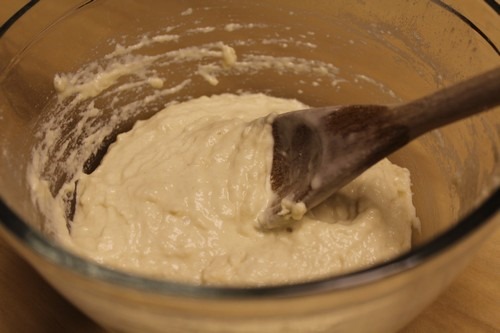
2) The dough ferments at 2 stages:
2a) 4 hours at a temperature 70-75°F, it should grow at least twice its size, will be lumpy looking at this stage and have larger and smaller bubbles.
2b) Pour the sponge in a bowl and whisk thoroughly to remove all the gas out of it and fill it with oxygen. Cover and let sit for 10-12 hours (overnight) at room temperature. Dough will rise again in half and very often shows smaller bubbles.
3) Now the sponge is ready for kneading: pour in the water and stir until smooth. Add the flour, mix well and give the autolysis a chance to do it’s magic for 40-50 minutes.
4) Add the salt and quickly knead the dough, if it is too sticky add a little four, but be careful not to add too much.
5) Let ferment for 2-2.5 hours. Fold twice after 1 hour and 1 1/2 hour.
6) Form a loaf and let proof in a basket for 1 1/2 hours (until doubled in size) covered with a towel in a draft free place.
1st try. I was excited at this point and ready to bake it. Then poof it stuck to the basket and deflated and I had to reshape and let it proof again.
2nd try (an hour later). I brushed the basket out and dusted it with a lot of flour this time. The loaf had doubled in size again, and I tried once more to remove it, but it stuck – again.
3rd try (another hour or so later). I switched baskets and dusted it with a lot of rice flour and all-purpose flour. This seemed to do the trick – mostly.
7) Preheat oven to 450°F with a baking stone on the middle rack. The original formula states to bake the loaf at 240°C which converts to 464°F so I baked it at 450°F.
8) Gently flip the loaf over to a piece of parchment paper (or your baking sheet) if you dare. Then score the loaf in the pattern of your choice and transfer it to your baking stone.
You can see where the dough got stuck on the left side. It wasn’t too bad, but still a little frustrating.
9) Spritz the loaf with water and bake at 450°F for 10 minutes. Spritz with water 2 more times at 30-second intervals, then lower the temperature to 400°F. and continue baking for an additional 20 minutes. The original formula states to lower it to 200°C and that converts to 392°F.
10) Let the loaf cool down for at least half an hour before slicing and eating.
After I reshaped and proofed the loaf three times in a row, I didn’t think it would have nice holes, but it proved me wrong. This bread is very light-colored due to the Reisling, but the crust was chewy and the crumb had a delicious texture and flavor.
I brought this loaf over to a friend’s house to taste test it and he loved it so much, it didn’t come home with me. He said it was perfect. I guess beauty and taste are in the eyes and mouth of the beholder. I was just pleased that he liked it.
I enjoyed baking with the BBBs again this month.
Happy Baking!
Cathy
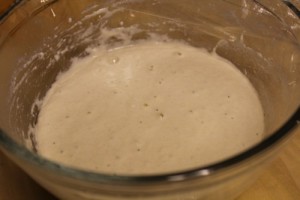
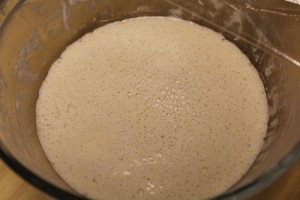
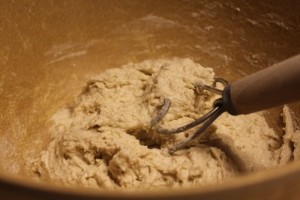
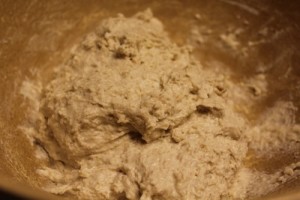
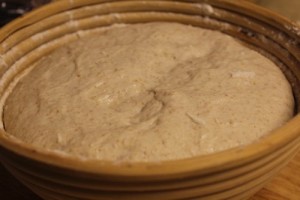
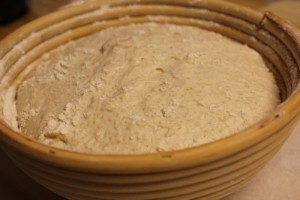
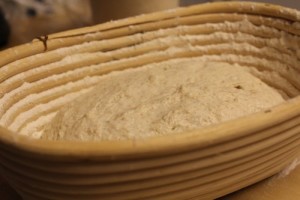
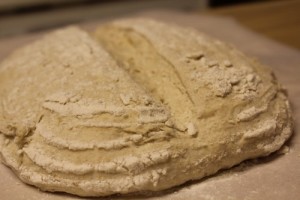
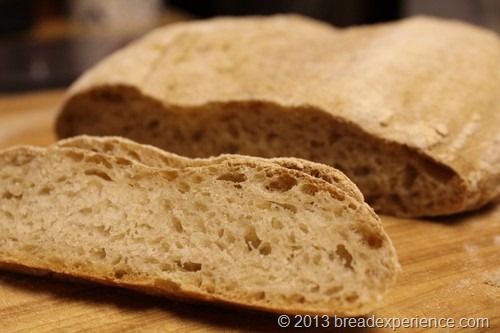
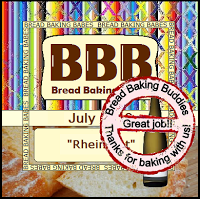
Karen Kerr says
I know that feeling when nothing seems to go right with the dough. This was definitely a sticky dough. Your holes look fantastic and I’m sure it tasted amazing!
Elizabeth says
Who cares that it’s a little flat? The crumb looks perfect!
Isn’t it amazing how differently this bread turns out depending on the circumstances? Mine wasn’t particularly sticky (although I didn’t use a natural starter) but it did take forever to rise.
Favourite line: “The loaf only stuck a little bit the third time, so I decided to go with it.” Yes!! And how great is it that you proved once again that bread just wants to be bread.
Many thanks for sharing your experiences and for baking with us again.
Cathy W. says
Yes, it is amazing how each bread has it’s own personality. I agree, bread just wants to be bread. And, it works better when I get out of the way. Lol…
Sleepy says
Looks pretty scrummy, great bread for eating with a chunk of cheese. I look forward to trying this at the weekend. Thanks for sharing.
Sweet and That's it says
Happy ending, this is what count, isn’t it?
I had the same “sticky and reshape” experience (almost thought: I’ll never achieve it) and was so happy when the bread turned out to be nice and yummy.
Never give up – that’s what bread it teaching us:-)
All the best!
Cathy W. says
Sleepy, This is a scrummy bread. I like that terminology. Do try it, you’ll enjoy it.
Cathy W. says
Yes, a happy ending is all that matters. Thanks!
MyKitchenInHalfCups says
I’d say good flavor wins over looks any day. Besides that it looks very good to me.
Thanks for being such a true bread lover!
Now I really want to try the spelt on the grill … pizza, that’s neat.